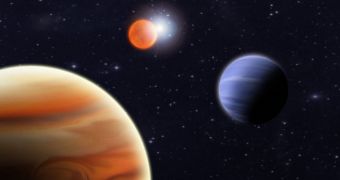Astronomers say that they were recently able to confirm the existence of two Jupiter-class exoplanets in orbit around a pair of stars called a binary system. This was thought to be nearly impossible until now, due to the interactions that develop in such a cosmic structure.
The stars in this particular binary pair are extremely close to each other, which means that their gravitational interplay is sending ripples in the area in their immediate vicinity. This is where the two exoplanets were found.
According to existing theories in astrophysics, these planets should not exist at all. If they developed over millions of years it's not because their parent stars made this easier.
Experts who have had a chance to look at the binary system NN Serpentis say it's made up of a relatively large white dwarf, about 2.3 times larger than the Earth, and another, smaller star, featuring just one tenth the mass of the Sun.
In spite of its small size, the white dwarf is heated to temperatures reaching as much as 89,500 degrees Fahrenheit (49,700 degrees Celsius). This is the equivalent of nine times the temperature levels on the Sun.
White dwarfs are the collapsed remnants of past Sun-like stars, that exhausted their hydrogen fuel, and then continue to burn the remaining helium for many billions of years.
The thing about the two stars in NN Serpentis is that they area located very close to each other, which means that their individual gravitational pulls can cause significant interactions in their surrounding areas.
Because the binary system is located in the same plane as Earth, astronomers can observe its 3-hour variations. In one such study, investigators found that two exoplanets may be exerting their influence on the stars.
The two bodies played an important role in altering the eclipse schedule the team was seeing, experts say. The largest of the two extrasolar planets was about 6 times more massive than Jupiter.
It orbits its parent stars a distance of about 558 million miles, which is extremely close. A year on this exoplanet takes about 15.5 years to conclude.
The second exoplanet is located a lot closer to the binary system, as it completes a full rotation around the star in about 7.75 Earth years. It has a mass about 1.6 times that of Jupiter.
Details of the new investigations were published in the latest issue of the esteemed scientific journal Astronomy & Astrophysics, Space reports.

 14 DAY TRIAL //
14 DAY TRIAL //